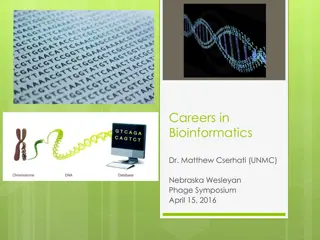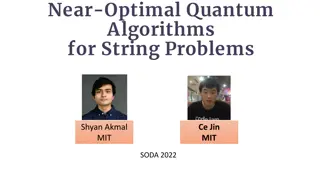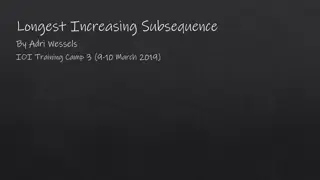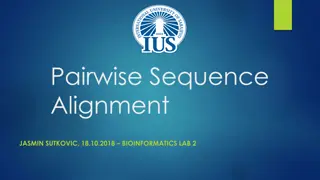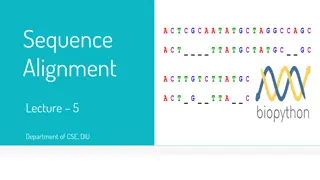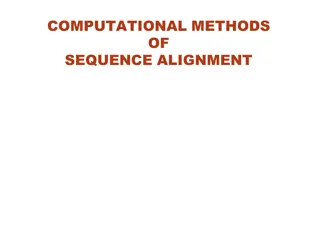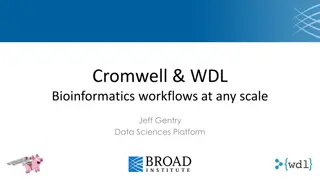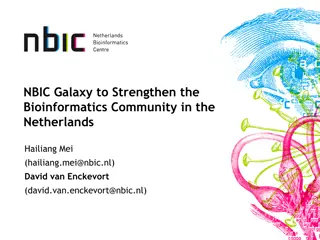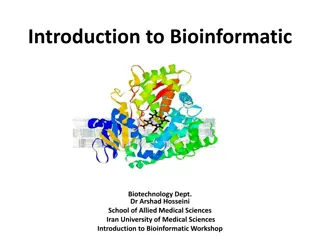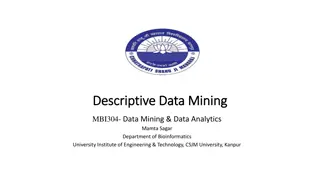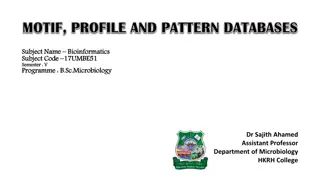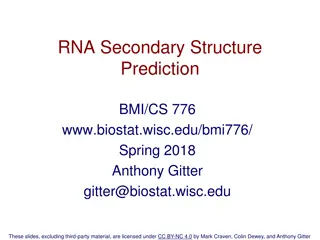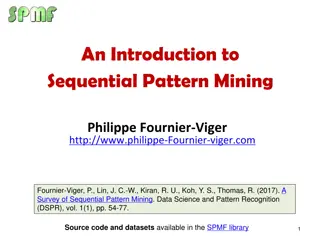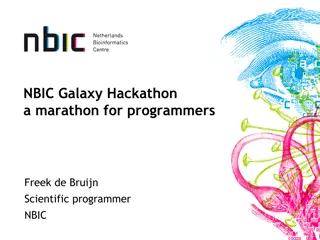Understanding Longest Common Subsequences in Bioinformatics
DNA Sequence Alignment is a crucial task in bioinformatics, where dynamic programming helps in finding the best alignment between DNA strings efficiently. The Longest Common Subsequence (LCS) problem aims to discover the longest shared subsequence between two strings, offering applications in DNA similarity testing. While a brute-force approach to solving the LCS problem is possible, it can be highly inefficient due to its exponential time complexity.
Download Presentation

Please find below an Image/Link to download the presentation.
The content on the website is provided AS IS for your information and personal use only. It may not be sold, licensed, or shared on other websites without obtaining consent from the author. Download presentation by click this link. If you encounter any issues during the download, it is possible that the publisher has removed the file from their server.
E N D
Presentation Transcript
Longest Common Subsequences Michael T. Goodrich University of California, Irvine
Application: DNA Sequence Alignment DNA sequences can be viewed as strings of A, C, G, and T characters, which represent nucleotides. Finding the similarities between two DNA sequences is an important computation performed in bioinformatics. For instance, when comparing the DNA of different organisms, such alignments can highlight the locations where those organisms have identical DNA patterns.
Application: DNA Sequence Alignment Finding the best alignment between two DNA strings involves minimizing the number of changes to convert one string to the other. A brute-force search would take exponential time, but we can do much better using dynamic programming.
Dynamic Programming Applies to a problem that at first seems to require a lot of time (possibly exponential), provided we have: Simple subproblems: the subproblems can be defined in terms of a few variables, such as j, k, l, m, and so on. Subproblem optimality: the global optimum value can be defined in terms of optimal subproblems Subproblem overlap: the subproblems are not independent, but instead they overlap (hence, should be constructed bottom-up).
Subsequences A subsequence of a character string x0x1x2 xn-1is a string of the form xi1xi2 xik, where ij < ij+1. Not the same as substring! Example String: ABCDEFGHIJK Subsequence: ACEGJIK Subsequence: DFGHK Not subsequence: DAGH
The Longest Common Subsequence (LCS) Problem Given two strings X and Y, the longest common subsequence (LCS) problem is to find a longest subsequence common to both X and Y Has applications to DNA similarity testing (alphabet is {A,C,G,T}) Example: ABCDEFG and XZACKDFWGH have ACDFG as a longest common subsequence
A Poor Approach to the LCS Problem A Brute-force solution: Enumerate all subsequences of X Test which ones are also subsequences of Y Pick the longest one. Analysis: If X is of length n, then it has 2n subsequences This is an exponential-time algorithm!
LCS 8 A Dynamic-Programming Approach to the LCS Problem Define L[i,j] to be the length of the longest common subsequence of X[0..i] and Y[0..j]. Allow for -1 as an index, so L[-1,k] = 0 and L[k,-1]=0, to indicate that the null part of X or Y has no match with the other. Then we can define L[i,j] in the general case as follows: 1. If xi=yj, then L[i,j] = L[i-1,j-1] + 1 (we can add this match) 2. If xi yj, then L[i,j] = max{L[i-1,j], L[i,j-1]} (we have no match here) Case 1: Case 2:
An LCS Algorithm Algorithm LCS(X,Y ): Input: Strings X and Y with n and m elements, respectively Output: For i = 0, ,n-1, j = 0,...,m-1, the length L[i, j] of a longest string that is a subsequence of both the string X[0..i] = x0x1x2 xi and the string Y [0.. j] = y0y1y2 yj for i =1 to n-1 do L[i,-1] = 0 for j =0 to m-1 do L[-1,j] = 0 for i =0 to n-1 do for j =0 to m-1 do if xi = yjthen L[i, j] = L[i-1, j-1] + 1 else L[i, j] = max{L[i-1, j] , L[i, j-1]} return array L
Analysis of LCS Algorithm We have two nested loops The outer one iterates n times The inner one iterates m times Thus, the total running time is O(nm) For example, if n = 1 million and m = 1 million, and we can do ops in 1 ns, then we need approx. 17 minutes. Answer is contained in L[n,m] (and the subsequence can be recovered from the L table). This takes O(nm) space, however! For example, if n = 1 million and m = 1 million, then we need over 1 TB of memory for the L table!
Hirschbergs Algorithm Hirschberg s algorithm is a way of computing the LCS in linear space. Dan Hirschberg is a faculty member in the Department of Computer Science at University of California, Irvine. He teaches Algorithms and Data Compression in the MCS program.
Idea #1 When we are computing the L table, we only need to store the previous row and the current row. If we just want to know the last row of the LCS (e.g., to compute the length of the LCS), this is enough to achieve linear space.
Review of the LCS Algorithm To match Hirschberg s notation, let A be string of length m and B be string of length n (both indexed starting from 1).
Applying Idea #1 Use a 2 x n matrix, K, instead of L. Let A be string of length m and B be string of length n (indexed starting from 1). The following algorithm gives the last line, LL, of the L table:
Idea #2: Divide and Conquer Algorithm Where does the LCS path cross the middle column of the L table? For i=m/2, find the place, k, where the LCS path crosses the middle column using Algorithm B. Then recursively find the LCS for A[1,i] and B[1,k] and the LCS for A[i+1,m] and B[k+1,n].
Algorithm Analysis Space is O(n + m). Time: T(m,n) = T(m/2, j) + T(m/2, n-j) + cnm
Prove by induction that T(m,n) <= 2cmn In class





